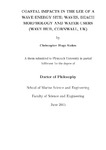COASTAL IMPACTS IN THE LEE OF A WAVE ENERGY SITE: WAVES, BEACH MORPHOLOGY AND WATER-USERS (WAVE HUB, CORNWALL, UK)
| dc.contributor.supervisor | Beaumont, Emily | |
| dc.contributor.author | Stokes, Christopher Hugo | |
| dc.contributor.other | School of Biological and Marine Sciences | en_US |
| dc.date.accessioned | 2016-02-10T11:55:50Z | |
| dc.date.available | 2016-02-10T11:55:50Z | |
| dc.date.issued | 2015 | |
| dc.date.issued | 2015 | |
| dc.identifier | 308501 | en_US |
| dc.identifier.uri | http://hdl.handle.net/10026.1/4303 | |
| dc.description.abstract |
The Wave Hub facility in Cornwall (South West UK) is a marine renewables test site, predominantly designed for the purpose of trialling wave energy converters prior to commercialisation. Beach water-users such as bathers and surfers are of economic importance to tourism in Cornwall, and during the Wave Hub consultation there were concerns among stakeholders that wave energy extraction would reduce the height and quality of coastal waves for surfing, as well as affecting sediment transport and beach morphology. This thesis investigates the interaction between wave conditions, beach morphology, and beach water-users, and proposes how a wave climate altered by wave energy extraction is likely to alter these interactions. A multidisciplinary research approach is adopted, involving the collection of qualitative and quantitative social data, the collection of over 5 years of physical wave and beach morphology data, and predictive modelling of the effects of an attenuated wave climate. Quantitative, structured interview data from 403 water-users, collected at two beaches (Perranporth and Porthtowan) in the lee of Wave Hub, indicate that the population of water-users in the area is predominantly made up of surfers (53%), but bodyboarding and swimming/bathing are also popular activities (29% and 11%, respectively). In-depth semi-structured interviews reveal that water-user perceptions of wave energy extraction and its potential coastal impacts are constructed using intuitive risk perceptions, rather than technical understanding. These risk perceptions are constructed through a weighing of their perception of wave energy devices ('technology') and their perception of the coastal environment ('nature'). To investigate how waves are perceived, nearshore wave buoy measurements collected in 14 m water depth and transformed to breaking height, are compared to concurrent visual observations of mean breaker height and period. On average water-users underestimated significant wave height and period by 48% and 17%, respectively. Accounting for variations in wave perception, the wave preferences of different water-user groups are determined. Water-users are found to share a common preference towards wave periods of 9 - 20 s, but different water-user groups are found to have different ranges of preferred wave height, which is found to govern whether wave energy extraction will decrease or increase the occurrence of preferred waves. Previous research indicates that three-dimensional (3D) beach morphology with crescentic bar and rip features is the primary controller of surf-zone hazard, and also strongly influences the quality of surfing waves at the coast. A dataset of 5.5 years of quasi-weekly bar measurements, and quasi-monthly intertidal surveys from Perranporth beach is used to quantify seasonal to inter-annual changes in three-dimensionality. Integrated, cumulative fluctuations in wave steepness, wave power, and relative tide range that occur over seasonal time scales are shown to be well correlated to seasonal fluctuations in beach three-dimensionality. 3D morphology is well related to a disequilibrium term that predicts increases or decreases in three-dimensionality by examining the difference between instantaneous wave conditions and a temporally varying equilibrium condition, based on a weighted average of antecedent waves. This indicates that periods of wave regime change between erosive winter conditions with high steepness waves and accretive summer conditions with low steepness waves are related to the growth of 3D features, and vice versa, while extended periods with similar wave conditions drive the beach towards equilibrium. Using a range of realistic and extreme coastal wave height attenuation scenarios determined from previous Wave Hub modelling studies, it is predicted that none of the scenarios will have a universally positive or negative effect on the occurrence of wave conditions preferred by water-users. When used to predict beach three-dimensionality at Perranporth beach, the attenuated wave climates are found to reduce the variability in three-dimensionality. Even an extreme and unrealistic level of wave energy extraction (100% energy capture) was shown to have an insignificant effect on the occurrence of preferred waves, and only under an extraction scenario where the impact was not varied with wave frequency did this level of attenuation have a significant effect on the predicted beach three-dimensionality. The inshore wave attenuation from Wave Hub is therefore likely to have an insignificant effect on wave conditions and beach morphology of relevance to beach water-users. A number of observations and recommendations are discussed for the development of a sound and robust methodological approach, which can be used to investigate the effects of wave energy extraction on beach water-users at future wave farm sites. | en_US |
| dc.language.iso | en | en_US |
| dc.publisher | Plymouth University | en_US |
| dc.subject | Marine Renewable Energy | en_US |
| dc.subject | Beach morphology | en_US |
| dc.subject | Wave perception | en_US |
| dc.subject | Water users | en_US |
| dc.subject | Wave energy | en_US |
| dc.title | COASTAL IMPACTS IN THE LEE OF A WAVE ENERGY SITE: WAVES, BEACH MORPHOLOGY AND WATER-USERS (WAVE HUB, CORNWALL, UK) | en_US |
| dc.type | Thesis | |
| plymouth.version | Full version | en_US |
| dc.identifier.doi | http://dx.doi.org/10.24382/4580 | |
| dc.identifier.doi | http://dx.doi.org/10.24382/4580 |
Files in this item
This item appears in the following Collection(s)
-
01 Research Theses Main Collection
Research Theses Main


